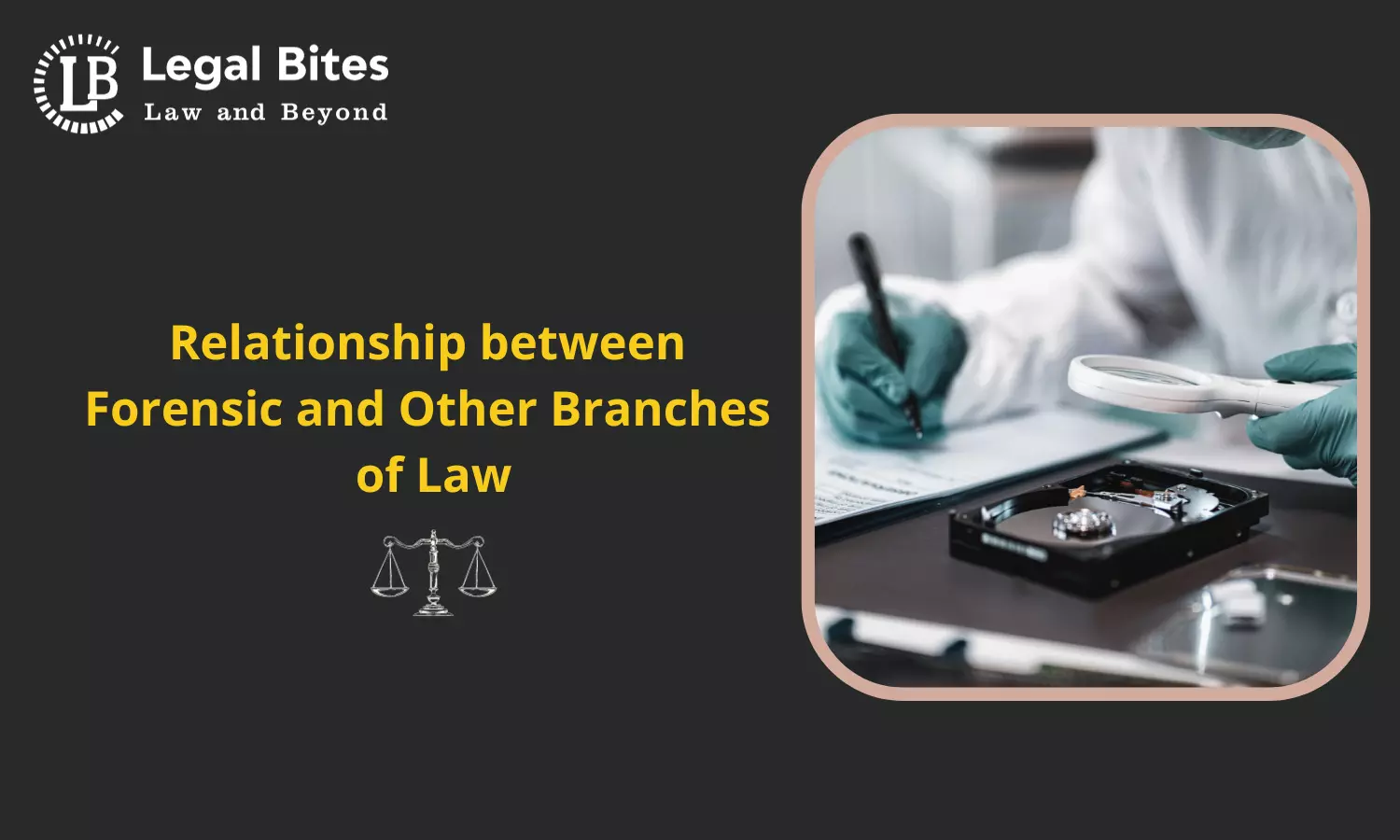Relationship between Forensic and Other Branches of Law
Explore the intricate link between forensic law and other legal branches, shaping justice. #ForensicLawRelations

The article 'Relationship between Forensic and Other Branches of Law' provides a thorough understanding of the multifaceted relationships between forensic law and other branches of law, illustrating how their interconnection shapes the legal landscape and influences the pursuit of justice.
Introduction
According to Woodrow, Wilson: “Law is that portion of established habits and thoughts of mankind which has gained distinct and formal recognition in the shape of uniform rules backed by the authority and power of the government.” Basically, the Law serves as a guideline as to what is accepted in society. Criminal law punishes an individual who commits criminal offences. Indian Penal Code, 1860 is a substantive law and the Code of Criminal Procedure is a procedural law. The former deals with the offences and the latter describes the procedure of investigation, prosecution and adjudication of criminal cases.
The principle of Presumption of Innocence is followed strictly in India. Blackstone said:
“the law holds that it is better that ten guilty persons escape, than that one innocent suffer.
Forensic Law: History
The word forensic comes from the latin term 'forensis' which means forum.
Medieval Period
The first documentation of the use of forensics is found in the Chinese book titled Xi Yuan Lu (roughly translated as Washing away the Mistakes) written in 1248 in China. The book centres on the requirement for a post-mortem examination report in an examination, ensuring authentication amid an examination, reasons for making dissection come about open in a fair way, and strategies.
The strategy makes a difference in making cleaning agents and causes covered-up wounds by carcasses and bones to return in daylight. Beneath a layer of oil and ruddy vinegar, this book moreover shows how to calculate the time of passing based on climate and creepy crawlies, and portrays ways to wash the body to consider diverse causes of passing. So, at that time, the book pointed out the contrast between killing and suicide.
Modern Period
In 1659, according to the Merriam-Webster Dictionary, the term Forensics was first considered an official word of the English language, even after having been used in medical works for several years. Today it is used frequently in our daily lives. Two examples of the use of forensic science in personal proceedings in English law demonstrate the increasing use of logic and procedure at the time of investigation. In 1784, in Lancaster, John Toms was accused of murdering Edward Culshaw with a pistol. When Culshaw's body was examined, a piece of gun used to store powder and bullets in the muzzle of the gun was found in his head wound, which completely matched a torn newspaper discovered in Tom's pocket, leading to his conviction.
A chemical testing laboratory in Madras in 1849 was used to isolate, detect and estimate different types of venom in the human body. The Criminal Investigation Department (CID) and the Anthropometric Department, responsible for maintaining anthropometric records of criminals, were established in the 19th century. The world's first fingerprint office was established in Calcutta, India in 1897. Likewise, the Serology Department, Fingerprint Department, Ballistics Laboratory, Forensic Laboratory State, etc. have also been created. Although these have been established at such an early age and caused substantive progress, certain limitations and challenges exist at the present time.
Nature and Scope
Forensic reports prove beneficial in deciding cases, but some cases are completely ignored by judges due to pressure or lack of accurate evidence to support the report. In the famous case (Smt.) Nupur Talwar v. State of U.P, Criminal Appeal No: 293 of 2014, the victim's parents were accused of murdering her and their servant. They were accused of honour killing, although forensic reports along with drug tests denied the act. In many cases of this type, medico-legal reports are not presented even when they are required and judgments are made without taking into account the medical aspects of the victim.
So, Indian law has loopholes when it comes to medico-legal angles. It is correct to say that both the effectiveness and reliability of forensic evidence depend on the case, and the existence of merits and demerits in the Indian legal system in the handling of such evidence can be seen.
Relationship with Other Branches of Law
Forensic investigation plays an important role in the criminal justice system. The forensic investigation determines various aspects of the particular case which will help in the court proceedings. For example, fingerprints of the suspects, DNA testing via hairs, saliva or any other substance, and blood tests to determine the consumption of alcohol, drugs or any other narcotics, etc. From all these things it becomes easy to catch the real culprit and put him behind bars.
Legal science works at the intersection of law and science. Whereas its authentic affiliation has been essential with criminal equity, modern researchers are progressively contributing to respectful things and administrative spaces. This energetic field has risen as an unused skyline inside the lawful scene, charting modern roads of investigation.
Criminal Law
This is based on a psychological report that is collected from a criminal and helps to build a thorough social and psychological picture of the offender. Criminal profiling's fundamental steps include, among other things, a thorough examination of the crime scene, examination of the evidence and drawing comparisons with similar incidents in the past, evaluation of the victim's background and activities, consideration of all potential motivations for the offender, and creation of a detailed description of the suspects to compare with previous cases.
Cyber Law
The examination of evidence found on computers and media storage devices like flash drives and hard drives is known as cyber criminalistics. Its major objective is to locate, store, retrieve, assess, and disseminate digital facts and ideas. It is mostly utilized to look into legal situations and crimes.
International Law
The use of forensic sciences at international criminal tribunals prompts scientific issues while also bringing forensic sciences' limitations to the attention of judges and trial lawyers. With an emphasis on the work of the jurisprudence of the International Criminal Court. Even at the level of international criminal tribunals, forensic evidence can affect the probative value of the evidence. Defence attorneys may be able to get potential exculpatory facts at trial if they have a sufficient understanding of the fundamentals of forensic sciences and the guiding principles of this field. For example, some modern forensic methods, such as probabilistic genotyping, can be quite effective in determining guilt or innocence.
Family Law
The use of digital services has increased in our lives. This implies that you might discover evidence on your PC or Mac, smartphone, social media, email, and other devices. These sources of digitally recorded data are frequently pivotal in family law court hearings and trials. Computer forensics is essential for securing electronic evidence in any family court lawsuit.
The mobile digital revolution and the development of digital forensics have occurred in the last ten years. Smartphones may leave a massive digital trail because of their numerous apps and network connections, which can store data that would fill an entire home if printed on paper. Although it is simple to gather information, it is also simple to remove data, message content, or entire programs. When checking a phone to determine if there have been any inappropriate or forbidden contacts, there is a chance that the content may appear to have disappeared
Environmental Law
Criminal punishments have been the conventional method used in India to combat environmental degradation. National Green Tribunal play a key role in deciding environmental issues. Environmental Forensic Experts have a better understanding to apply scientific techniques in order to address environmental concerns.
Intellectual Property Rights
IP forensic examination is a new subcategory generated by the burden of evidentiary proof in this digital age. Economic damages, royalty infringement, and blatant forgeries can all be found by a forensic analysis of the parties' computers and cloud data. Forensic investigations provide admissible forensic reports that can be backed up by expert witness testimony. IP theft occurs in both the business and private sectors in addition to the internet. Forensic experts with their skill analyze digital evidence to decide the loss suffered due to IP infringement.
Legal Provisions: Relevant for Forensic Evidence
Indian Evidence Act
Section 45:
It discusses in detail the opinions of experts. The court relies on the opinion of an expert on all important matters that require special knowledge, e.g. DNA and handwriting analysis.
Section 46 says,
Facts not otherwise relevant, are relevant if they support or are inconsistent with the opinions of experts, when such opinions are relevant.
Code of Criminal Procedure
Section 53 lays emphasis: At the request of a police officer using reasonable force, the accused may be examined by a physician.
Section 207: Supply to the accused of copy of the police report and other documents
Section 311: Power to summon material witness, or examine person present.
Conclusion
Forensic Law identifies various criminal activities with the use of distinct techniques to ascertain the cause of death and various other related issues. Medical examiners hold a pivotal role in the determination of death to decide natural causes or foul play. Scrutinizing scenes of crimes helps to get a vivid view of the suspect. Forensic Science is an important tool for criminal investigation. Forensic science reveals the truth and assists in the pursuit of justice.
Contributions from: Vaishnavi Parate and Apurva Neel
References
[1] Indian Evidence Act, 1872, Available Here
[2] Indian Penal Code 1860, Available Here
[3] Code of Criminal Procedure Act, 1973, Available Here
Important Links

